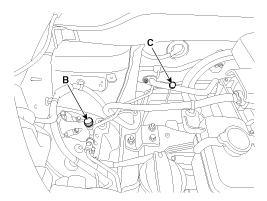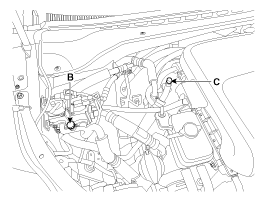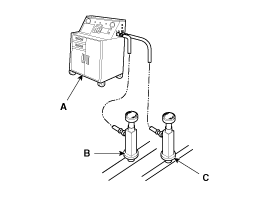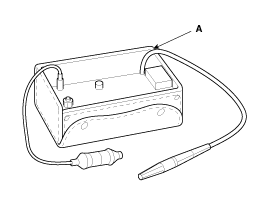Kia Soul EV: Air Conditioning System / Repair procedures
Kia Soul EV (PS EV) 2015-2020 Service Manual / Heating,Ventilation, Air Conditioning / Air Conditioning System / Repair procedures
| Refrigerant System Service Basics |
| • |
Since the electric compressor uses high-voltage, POE oil with high volumetric resistivity should be used. |
| • |
Do not use the same A/C recovery / charging station as in conventional belt-driven compressors. |
|
Refrigerant Recovery
Use only U.L.-listed service equipment that is certified to
meet the requirements of SAE J2210 when removing HFC-134a (R-134a) from
the air conditioning system.
|
If accidental system discharge occurs, ventilate work area before resuming to service.
Additional health and safety information may be obtained from the refrigerant and lubricant manufacturers.
| 1. |
Connect an R-134a refrigerant
Recovery/Recycling/Charging System (A) to the high-pressure
service port (B) and the low-pressure service port (C) as shown,
following the equipment manufacturer''s instructions.
[Without Heat Pump]
[With Heat Pump]
|
| 2. |
Measure the amount of refrigerant oil removed from the A/C
system after the recovery process is completed. Be sure to install the
same amount of new refrigerant oil back into the A/C system before
charging. |
System Evacuation
Use only U.L.-listed service equipment that is certified to
meet the requirements of SAE J2210 when removing HFC-134a (R-134a) from
the air conditioning system.
|
If accidental system discharge occurs, ventilate work area before resuming to service.
Additional health and safety information may be obtained from the refrigerant and lubricant manufacturers.
| 1. |
When an A/C System has been opened to the atmosphere, such as
during installation or repair, it must be evacuated using an R-134a
refrigerant Recovery/Recycling/Charging System. (If the system has been
open for several days, the receiver/dryer should be replaced, and the
system should be evacuated for several hours.) |
| 2. |
Connect an R-134a refrigerant
Recovery/Recycling/Charging System (A) to the high-pressure
service port (B) and the low-pressure service port (C) as shown,
following the equipment manufacturer''s instructions.
|
| 3. |
If the pressure does not reach over 93.3 kPa (700 mmHg, 27.6
in.Hg) in 10 minutes, there may be a leakage in the system. Partially
charge the system and check for any leakages (see Leak Test). |
| 4. |
Remove the low pressure valve from the low-pressure service port. |
System Charging
Use only U.L.-listed service equipment that is certified to
meet the requirements of SAE J2210 when removing HFC-134a (R-134a) from
the air conditioning system.
|
If accidental system discharge occurs, ventilate work area before resuming to service.
Additional health and safety information may be obtained from the refrigerant and lubricant manufacturers.
| 1. |
Connect an R-134a refrigerant
Recovery/Recycling/Charging System (A) to the high-pressure
service port (B) as shown, following the equipment manufacturer''s
instructions.
|
| 2. |
Add the same amount of new refrigerant oil to system that was
removed during recovery. Use only specified refrigerant oil. Charge the
system with R-134a refrigerant. Do not overcharge the system as it may
damage the compressor.
|
Refrigerant Leak Test
Always conduct a leak test with an electronic leak detector
whenever leakage of refrigerant is suspected and when conducting service
operations that accompany disassembling, loosening or connecting of
fittings.
|
If a gas leak is detected, proceed as follows:
| 1. |
Check the tightening torque of the connection fittings, and
if it is too loose, tighten to the proper torque. Using a leak detector
(A), check for gas leakage. |
| 2. |
If leakage continues even after the fitting has been
tightened, discharge the refrigerant from the system, disconnect the
fittings, and check their seating faces for damage. Replace at all times
even for a slight damage. |
| 3. |
Check the compressor oil and add oil if required. |
| 4. |
Charge the system and recheck for gas leaks. If no leaks are found, evacuate and charge the system again.
|
 Description and Operation
Description and Operation
Refrigeration Cycle
...
 Components and Components Location
Components and Components Location
Component Location Index
Engine Room
[Without Heat Pump]
1. Receiver-drier2. Condensor3. A/C Pressure Transducer (APT)4. Service port (Low pressure)5. Service port (High pressure)6. Sucti ...
Other information:
Kia Soul EV (PS EV) 2015-2020 Service Manual: Rear Door Window Glass Components and Components Location
Component Location 1. Rear door window glass ...
Kia Soul EV (PS EV) 2015-2020 Service Manual: Outer Condenser Description and Operation
Description Condenses high temp-high pressure refrigerant when in A/C Mode (same role as the condenser in a conventional system). Evaporates low temp-low pressure refrigerant when in Heating Mode (same role as the evaporator in a conventional system). It is designed as down-flow type to facilit ...
Copyright © www.ksoulev.com 2020-2025








